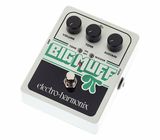If you want the "classic" Big Muff Pi tone, then buying this version may be pointless and a bit of a waste of the extra money. It can give you the "classic" Big Muff sound, 100% identical to the original (Wicker switch OFF, Tone switch ON). But with these added switches you have 2 variations of the Big Muff sound to try out. The "TONE" switch litterally puts the tone control circuit in or out of the signal path, so switching that to OFF gets rid of the ~1khz mid-scoop and also balances out the highs and lows more, giving you a kinda flat frequency curve but with that BMP fuzzy sustain still. The "WICKER" switch essentially adds in some more high end frequencies (3 frequencies apparently, but I couldn't tell you what those 3 are). So if you put both switches to ON you get to keep the 1khz scoop and tone control in general, and also get more high end in your tone on top of that classic sound.
So in summary...
WICKER OFF & TONE ON
100% the classic BMP sound, this is essentially like buying the original version (Boosted low end, 1khz mid-scoop & slightly attenuated high end relative to low end)
WICKER ON & TONE ON
Low end & 1khz mid-scoop the same as the classic BMP, but some of the high end frequencies are added back in rather than being attenuated (I don't mean the BMP is cutting high-end, like it does for the 1khz mids, but the classic BMP circuit let's through more low-end than it does high-end. So relative to each other the low end is higher... The WICKER switch ofsets some of this and allows 3 high-end frequencies to pass through more than the original)
WICKER ON & TONE OFF
The frequency shaping produced by the tone control knob is removed from the circuit, getting rid of the signature mid-scoop and producing a much more flat (relative to the original) frequency response. But as well as this you still have these 3 high-end frequencies being allowed to pass through the circuit without any attenuation. The result, essentially you get flatter mids, a little boost to the low-end and much more high-end in your tone, producing a much more "shrill" sounding fuzz than the classic thick bottom, scooped sounding tone of the BMP classic.

